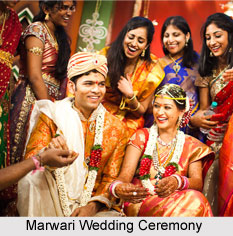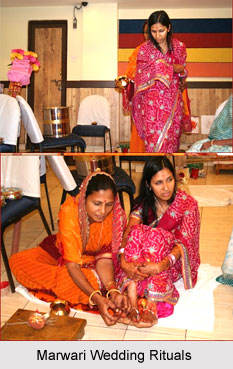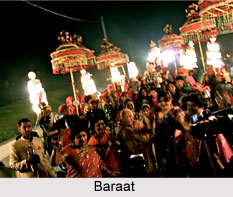 Marwari Wedding is a traditional and elaborate affair. Pre and post wedding ceremonies stretch for days where tradition and customs take precedence over everything else.
Marwari Wedding is a traditional and elaborate affair. Pre and post wedding ceremonies stretch for days where tradition and customs take precedence over everything else.
Pre Wedding Rituals
Engagement: The engagement ceremony or the "Sagai" takes place at the house of the groom. This is strictly all male affair. On this day, the bride`s brother puts "tilak" on the groom`s forehead. A sword, clothes, sweets etc. are given to the groom. "Ganapati Sthapna" and "Grih Shanti" is the performed a few days prior to the wedding, this is important as all ceremonies commence only after this ritual. A sword along with fruits sweets and other gifts are presented to the groom.
Pithi Dastoor: Engagement ceremony is followed by The Pithi Dastoor ceremony, which involves the bride/groom and continues until the day of the wedding. The actual ceremony consists of application of turmeric and sandal wood paste to the bride/ groom who cannot leave the house after this. The bride dresses in an orange Rajasthani dress and is then brought under a silken canopy, which is held up with swords at four corners by four ladies who must belong to the same clan as the bride. She is brought to the ladies gathering, who then apply the paste to her.
 Mehfils: Mehfils are an integral part of every Rajasthani wedding. It is usually held in the evenings, they are again segregated into the `ladies mehfil` and the `gents mehfil`. The guests perform the ghoomar (a special dance done in a group). The bride at the mehfil is given an important position to sit and watch the proceedings. If the ladies` mehfil is in progress at the groom`s house, then only the groom is privileged to attend the all-women affair. The men have their own mehfil, where singers perform and these are strictly all male.
Mehfils: Mehfils are an integral part of every Rajasthani wedding. It is usually held in the evenings, they are again segregated into the `ladies mehfil` and the `gents mehfil`. The guests perform the ghoomar (a special dance done in a group). The bride at the mehfil is given an important position to sit and watch the proceedings. If the ladies` mehfil is in progress at the groom`s house, then only the groom is privileged to attend the all-women affair. The men have their own mehfil, where singers perform and these are strictly all male.
Janev: In the Janev ceremony, the sacred thread is given to the would-be groom on the eve of his wedding. The groom is dressed in saffron robes like an ascetic and performs a havan before wearing the thread.
Palla Dastoor: On the day of wedding or maybe a day prior to it, the Palla Dastoor, which consists of clothes, jewellary and gifts for bride are brought to bride`s house by the groom`s relatives.
Baraat: The baraat consists only male members. The groom is usually dressed in a gold and orange traditional dress of achkan, turban and a churidar and jootis. All members, including the groom who rides an elephant or a horse, carry swords.
Wedding Ceremony
Aarti: As soon as the actual wedding ceremony begins the groom is taken inside to the ladies section where he is received by the bride`s mother with the traditional aarti, and is then taken to the mandap to perform the wedding rituals. The groom has to be accompanied only by a male member of the family, either a married relative or his younger brother or a younger male cousin. The bride must keep her face covered throughout the wedding ceremony. After jaimala or varmala ceremony, the bride and groom is taken to another mandap where rituals related to phera are performed.
Granthi-Bandhan: The next step is `granthi-bandhan` or tying the knot. In this the either the sister of the groom or the priest ties cloth around the groom`s waist is tied to the chunni of the bride. The ceremony is symbolic of the union of two individuals. From this day they become one entity.
Paanigrahan: The groom takes the bride`s hand in his hand. It is again a symbol of this most pious union. It signifies that they will now be together in good times and bad.
Pheras: Then the groom and the bride go around the fire. This act is called `pheras`. In a Marawari wedding only four `pheras` are done in the mandap, rest of the three pheras are performed at the entrance. Following the tradition, in the two pheras, the girl is in the front and in the other two the boy leads.
Ashwahrohan: In the Ashwarnarohan ceremony the girl puts her foot on a grinding stone. The custom is symbolic of steadfastness and symbolic of facing every challenge with courage. Then the brothers of the bride puts `kheel` or puffed rice in the bride`s hand, which are passed to the groom`s hand and then offered to the fire. This ritual is symbolic of brother`s happiness and wishes of prosperity for his sister and her husband.
 Vamang-Sthapana and Sindurdaan: Later, in a ceremony called ` vamang-sthpana` the groom requests the bride to sit on his left side, because the heart is in the left side of the body. This signifies that the groom is accepting the bride and is establishing her in his heart. This is followed by sindurdaan ceremony wherein the groom fills the bride`s centre hair parting with sindoor or vermillion.
Vamang-Sthapana and Sindurdaan: Later, in a ceremony called ` vamang-sthpana` the groom requests the bride to sit on his left side, because the heart is in the left side of the body. This signifies that the groom is accepting the bride and is establishing her in his heart. This is followed by sindurdaan ceremony wherein the groom fills the bride`s centre hair parting with sindoor or vermillion.
Saptapadi: The bride and the groom walk seven steps together. This signifies that till now they have walked alone but from now on, they will always walk together in synchronization. While observing the custom, the bride and the groom utter seven sentences, which are in fact promises, they make regarding their conduct towards each other. After this `pherpatta` is done which signifies that the bride can freely proceed to her in-laws house. After this the sister of the groom does the `sargunthi` or adorning of the girl`s hair. This ritual signifies acceptance of bride by the groom`s family.
Aanjhala Bharaai: Following the `aanjhala bharai` tradition, a bag full of money is put in the new bride`s lap by her father-in-law. This is his way of welcoming her into his family and also to make her aware of her family responsibilities. The bride then distributes a part of this money to her sister-in-law and her husband.
Paharavani: The groom is then taken for `paharavani` wherein he is made to sit on a new cloth or asana and is welcomed by a Tika. He is also given gifts in the form of money, clothes and other things for his personal use. A silver utensil or kachola is given to the groom`s father. The woman folk of the bride`s side then take the groom for the fun-filled `shloka kahalai` session wherein he is made to recite poems or dohas. After this, the bride worships the threshold (dahaleez) of her paternal home and breaks an earthen diya on it. The groom and the bride are escorted out and they leave for the groom`s house.
Bidai: At the time of the bidai, a coconut is placed under the wheel of the car before the bride lifts her veil for the husband after the wedding. At this stage, the groom usually gives a piece of jewelry to his bride.
Post Wedding Rituals
Grihapravesh: The bride still wears the veil while the puja and other ceremonies take place. A few games are played between the bride and the groom.
Pagelagni: This is a ceremony where the bride, still in veil, is formally introduced to all the family members of the groom who bless her and give her gifts. The veil is then finally removed.
More on Marriage System in Indian States
More on Indian Wedding Accessories
More on Indian Religious Weddings
More on Types of Marriages
See also
 Marwari Wedding is a traditional and elaborate affair. Pre and post wedding ceremonies stretch for days where tradition and customs take precedence over everything else.
Marwari Wedding is a traditional and elaborate affair. Pre and post wedding ceremonies stretch for days where tradition and customs take precedence over everything else.
 Mehfils: Mehfils are an integral part of every Rajasthani wedding. It is usually held in the evenings, they are again segregated into the `ladies mehfil` and the `gents mehfil`. The guests perform the ghoomar (a special dance done in a group). The bride at the mehfil is given an important position to sit and watch the proceedings. If the ladies` mehfil is in progress at the groom`s house, then only the groom is privileged to attend the all-women affair. The men have their own mehfil, where singers perform and these are strictly all male.
Mehfils: Mehfils are an integral part of every Rajasthani wedding. It is usually held in the evenings, they are again segregated into the `ladies mehfil` and the `gents mehfil`. The guests perform the ghoomar (a special dance done in a group). The bride at the mehfil is given an important position to sit and watch the proceedings. If the ladies` mehfil is in progress at the groom`s house, then only the groom is privileged to attend the all-women affair. The men have their own mehfil, where singers perform and these are strictly all male.
 Vamang-Sthapana and Sindurdaan: Later, in a ceremony called ` vamang-sthpana` the groom requests the bride to sit on his left side, because the heart is in the left side of the body. This signifies that the groom is accepting the bride and is establishing her in his heart. This is followed by sindurdaan ceremony wherein the groom fills the bride`s centre hair parting with sindoor or vermillion.
Vamang-Sthapana and Sindurdaan: Later, in a ceremony called ` vamang-sthpana` the groom requests the bride to sit on his left side, because the heart is in the left side of the body. This signifies that the groom is accepting the bride and is establishing her in his heart. This is followed by sindurdaan ceremony wherein the groom fills the bride`s centre hair parting with sindoor or vermillion.

















